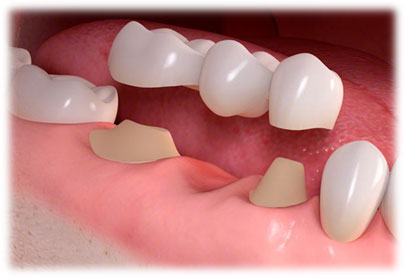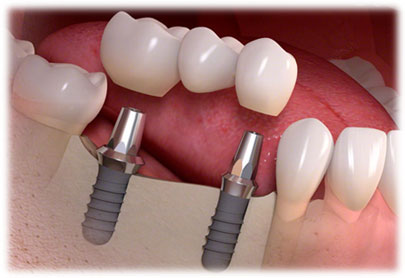

The fixed prosthesis replaces the natural dental elements with definitive and stable artifacts, these can be veneers and crowns. It is possible to replace a single tooth or multiple teeth with a fixed prosthesis if necessary and in this case we are talking about bridges (replaced of multiple teeth) cemented to natural support pillars and therefore not removable by the patient.

Tooth preparation is an operational act that aims to reduce abutment teeth to form what is called a "stump" in prosthetics. In essence, the tooth is reduced in size from all sides, preserving only the central part: this roughly corresponds to the removal of a thickness equal to the tooth enamel or slightly more. Once the dental pillars have been prepared, the dentist will take them the impression by inserting a metal or anatomical silicone/plastic impression tray in the shape of an arch or semi-arch depending on the impression to be taken containing a special soft paste in the patient's mouth. The teeth of the latter will sink into the paste until it has hardened completely (generally the operation lasts 2-3 minutes). Once the impression has been taken, the dentist will extract the impression holder from the patient's mouth with extreme delicacy in order to avoid possible alterations to the impression.
The impression will then be sent to the dental laboratory together with the relevant shape and color information. Within a few days the latter will return it to the dentist, who will carry out the test of the structure and the necessary and necessary modifications, the prosthetic product is sent back to the laboratory for cerimization, then the test is carried out with the "biscuit test" ceramic and the prosthetic product is sent back to the laboratory for final polishing, finally the prosthesis is delivered, fixing it with cement in the patient's mouth and all the information needed for its correct maintenance is provided (cleaning, use, precautions to be taken at the table, etc.).pulizia, utilizzo, accorgimenti da adottare a tavola, etc.).
It is advisable to use a fixed prosthesis if you have healthy teeth: in fact for creation of crowns and fixed bridges realizzazione di corone e ponti fissi it is essential to rely on a consistent number of residual pillars, not excessively distant from each other and capable of guaranteeing adequate stability. In this case, a fixed dental prosthesis is still the optimal solution from an aesthetic and biocompatible point of view, fully reproducing their functionality ensuring enviable stability, an impeccable smile and easy chewing.
Advantages of fixed dental prosthesis:
the mobile prosthesis is intended to replace a part or the entire dental arch and can be removed by the patient for the purpose of carrying out ordinary daily hygiene maneuvers. There mobile prosthesis can be:
– partial: anchored by means of hooks or attachments to the natural teeth and is usually made up of a metal structure from which it takes the name of skeletonized.
– total: in the absence of residual natural teeth or roots, the total resin prosthesis (denture) it replaces one or both dental arches, resting solely on the patient's mucous membranes and bone.

Although the stability of the prosthesis is compromised by gradual bone resorption (so much so that it requires regular "relining" by the dentist) and the masticatory effectiveness is reduced compared to other prosthetic solutions, the total prosthesis still represents a more economical and less complex to restore the patient's oral functions. The use of innovative materials (composites and ceramics) guarantees the functional, hypoallergenic and aesthetic validity of the result.
 3. COMBINED PROSTHESIS:
3. COMBINED PROSTHESIS:the combined prosthesis restores the effectiveness of the dental arch through the support of teeth or implants in osseointegrated titanium. The prosthesis is removable rimovibile but fixed and made stable by anchoring devices that ensure long-term functionality. It is possible to improve the stability of removable prostheses with minimally invasive interventions. These methods make it possible to significantly improve the quality of life of older patients by eliminating the psycho-physical stress caused by the operation.

the implant technique involves the replacement of individual dental elements or entire dental arches through the surgical insertion of titanium pillars to which the teeth are permanently anchoredThe use of artificial supports integrated into the mandibular or maxillary bone allows you to preserve the health of the teeth still present (filed and reduced during the application of bridges) and guarantee complete stability. Implantology today represents the best solution for functional and aesthetic rehabilitation of mastication.
©Implant House Albania. All Rights Reserved. Designed By: INALBANIA.AL